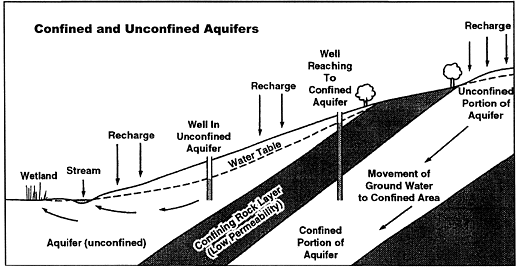The ABCs of Aquifers

When you are "talking groundwater," it won't be long before you will be asked to explain the word aquifer. There are many variations of geology and hydrology that may make an aquifer. Some aquifers extend over long distances and to great depths. However, many aquifers are small and localized. Aquifers contain groundwater, but not all sub-surface water is in aquifers! Geologic cross section figures are very useful when explaining groundwater issues.
In explanation, the word aquifer comes from the Latin words, aqua (water), and fer (to carry). An aquifer often is described as a sub-surface geologic formation(s) (solid rock and/or unconsolidated sediments) that contains groundwater in sufficient quantities to be used, or have the potential to be used, for drinking water supply or for commercial, industrial or agricultural purposes.
Groundwater nearly always is found when a well is drilled, although in some places, there may be a very low rate of flow to the well. How large does a well's yield have to be to qualify a saturated rock as an aquifer? Half a gallon a minute will provide 700 gallons a day, but many people would not describe such low-yielding rock formations as aquifers. So, by some definitions, many low-yielding domestic wells are not really in aquifers. Thus, all water wells pump groundwater, but they don't all pump from aquifers.
In general, there are three main categories of aquifers: unconfined, confined and perched. In reality, there can be a number of combinations and variations.
Unconfined aquifers are covered by permeable geologic formations (either solid rock or unconsolidated sediments), and the upper surface where the rock formations are fully saturated is called the water table. These aquifers also are known as water table aquifers. They receive recharge directly from the infiltration of rainfall and surface water.
Confined aquifers are those that are covered (confined) by an impermeable or semi-permeable layer of rock. Confined aquifers are not recharged directly by vertical infiltration. Confined aquifers need to be connected to an unconfined area through which recharge can occur. The confining impermeable layers rarely form a complete barrier to groundwater. There is generally some transfer or flow of groundwater between the confined aquifer and the confining layers.
In confined and unconfined aquifers there may be considerable amounts of groundwater that are stored in impermeable/semi-permeable sediments such as clays. Water from these sediments can reach a well if they are in contact with permeable layers that are intersected by the well. So, although clays are not thought usually thought of as aquifers, they may be a key part of the storage in an aquifer system. When aquifers are polluted, it is almost impossible to flush out contaminants from fine-grained clay layers where much of the aquifer's water may be stored.
Artesian aquifer is the name sometimes used to describe confined aquifers. In confined aquifers, groundwater is under pressure. The water level in a confined aquifer well may be close to the surface, perhaps many 10s or even hundreds of feet above the aquifer. An overflowing artesian well occurs where the water pressure in the aquifer is sufficient to raise water levels to cause natural flow at the surface. The term artesian often is used incorrectly to describe any well drilled into solid rock. Water levels in most aquifers vary with the season and during droughts. It is a debatable point whether an "empty" aquifer is still an aquifer, and there is no scientific agreement about what to call the permanently depleted portions of over-drafted aquifers. For purposes of wise groundwater protection policy, we should consider as aquifers the full vertical and horizontal extent of seasonally de-watered or over-pumped rock formations.
Perched aquifers occur where groundwater is perched above unsaturated rock formations as a result of a discontinuous impermeable layer. Perched aquifers are fairly common in glacial sediments. They also occur in other sedimentary formations where weathered layers, ancient soils or caliche (a calcareous layer common in semi-arid areas) have created impermeable zones.

Looking for a reprint of this article?
From high-res PDFs to custom plaques, order your copy today!



